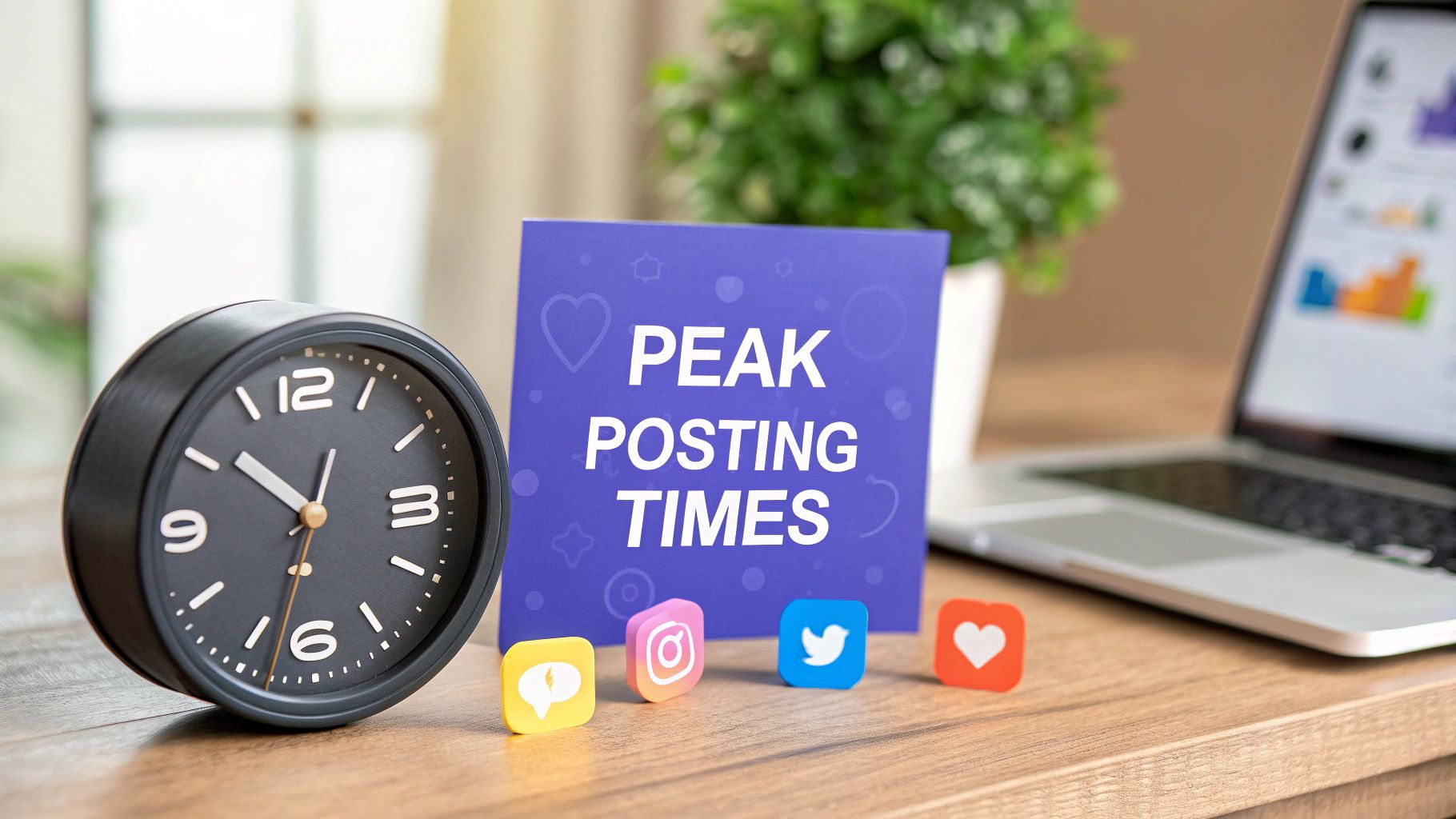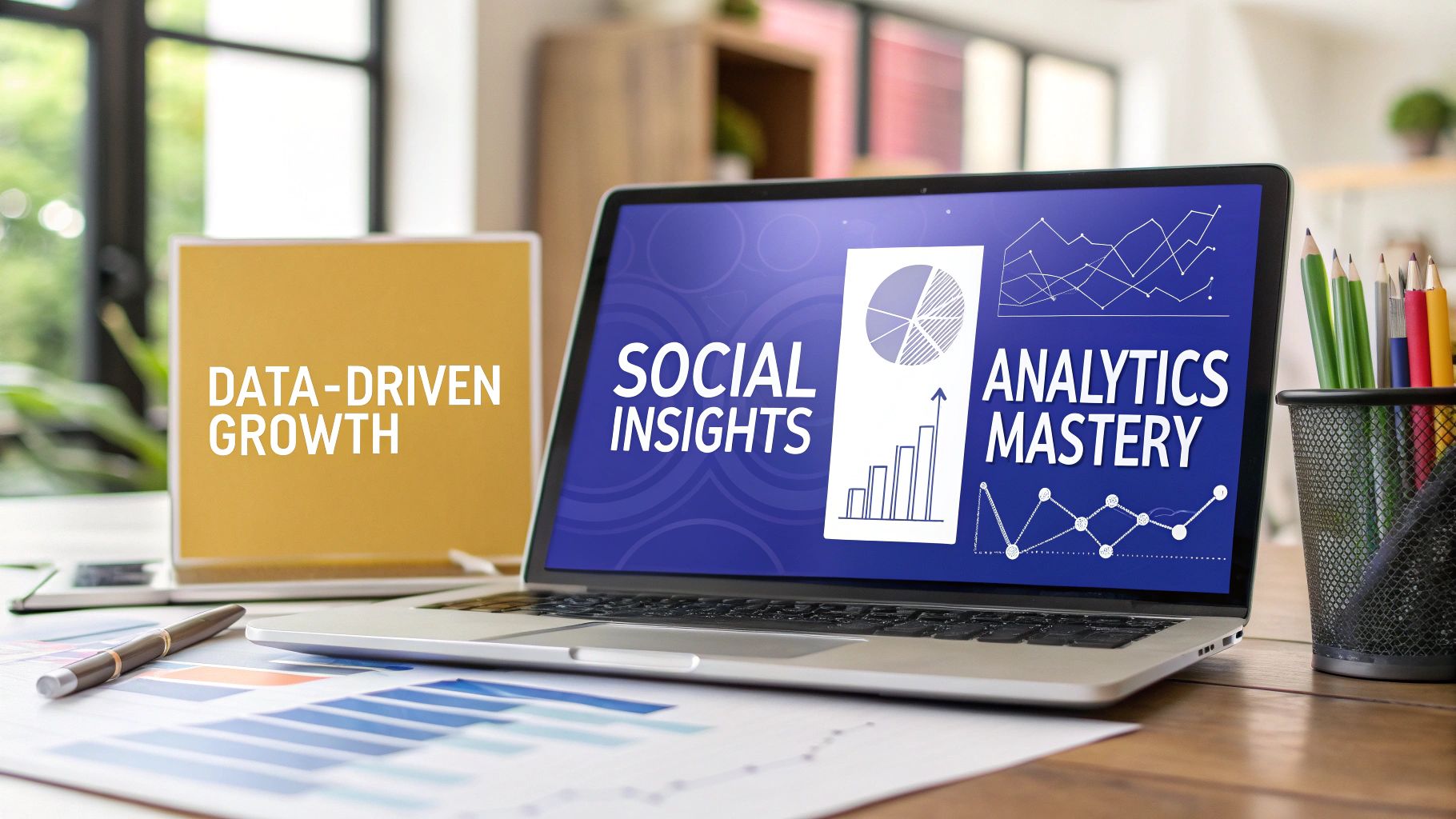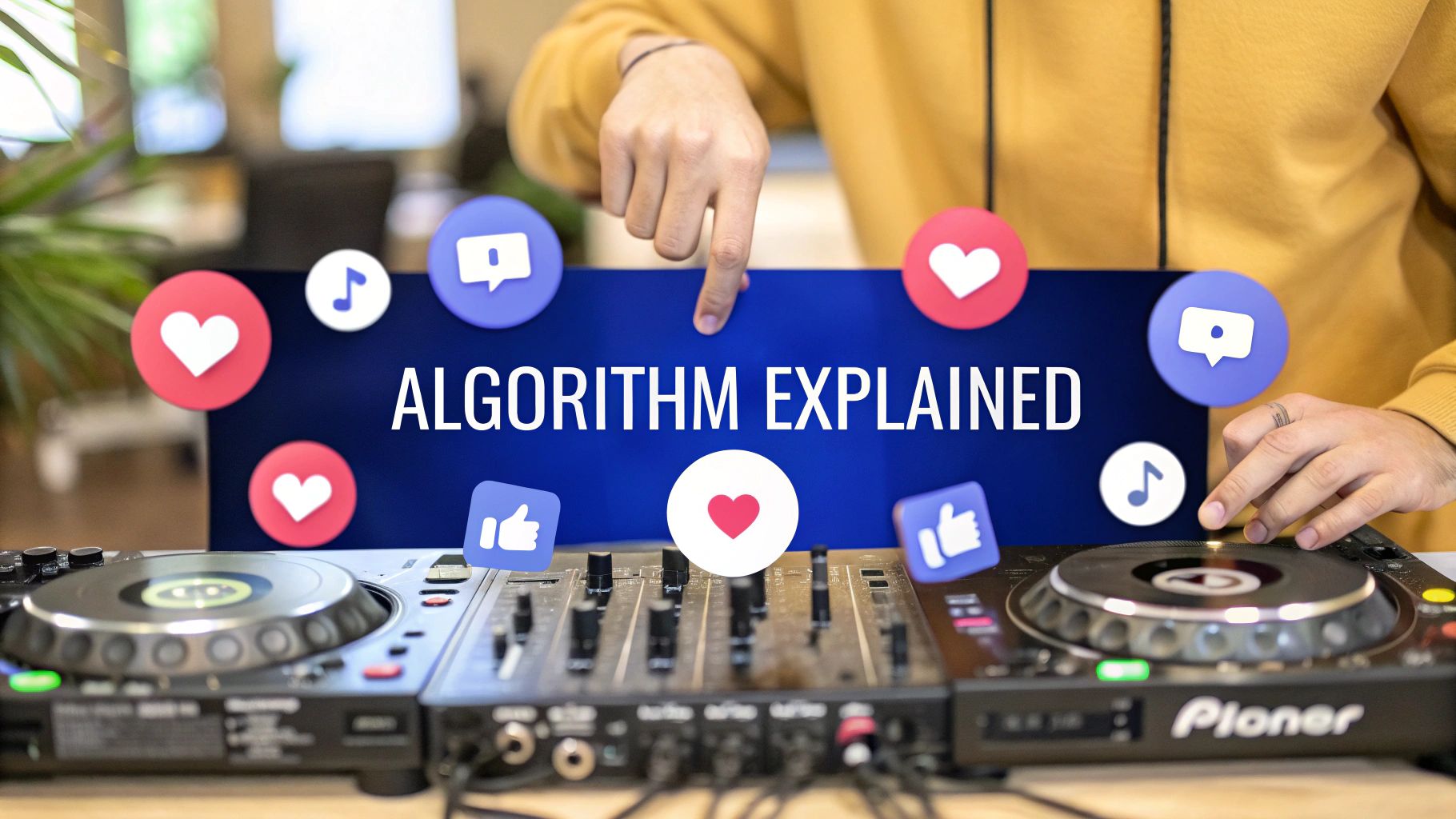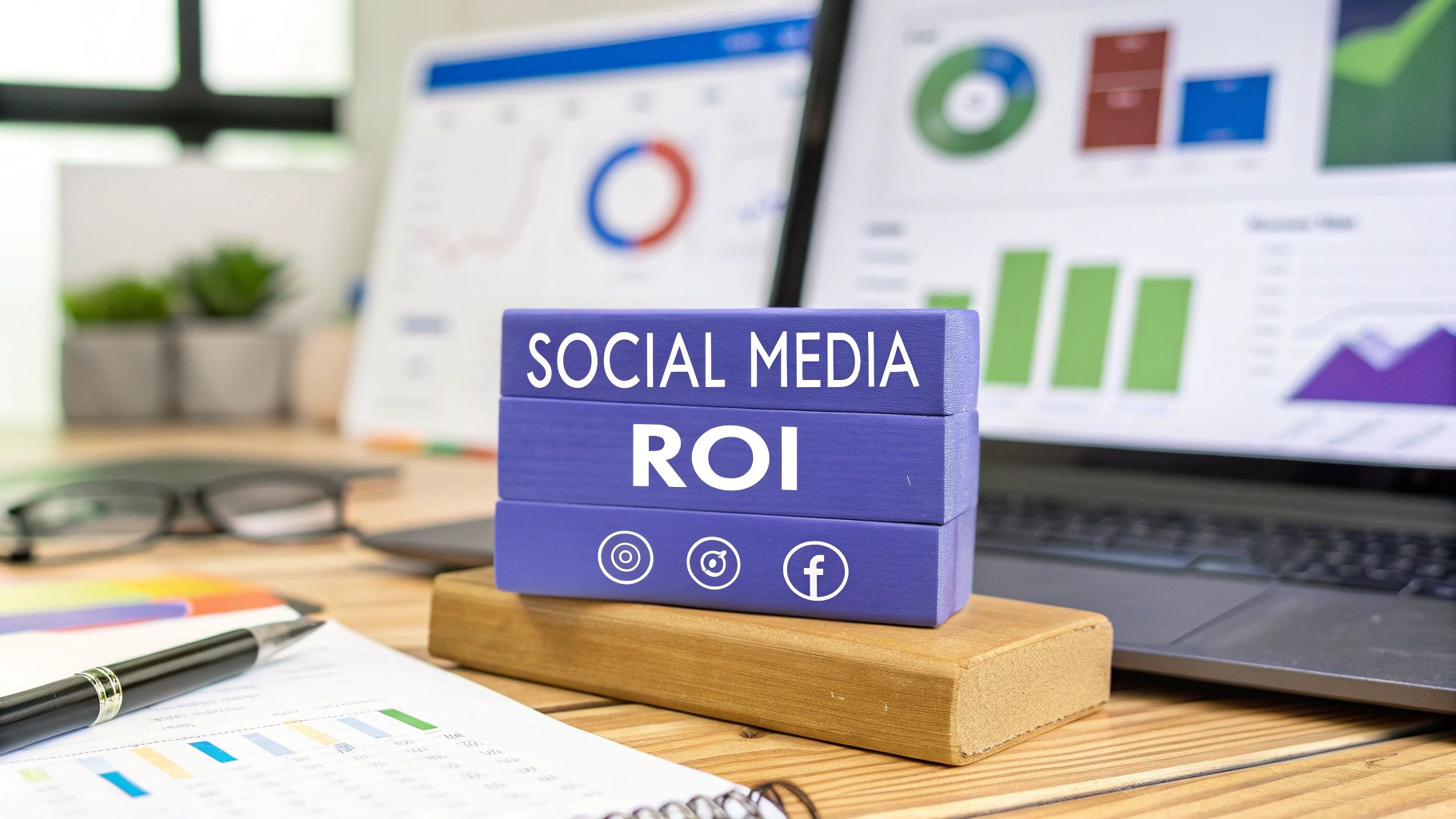Beyond 'Post and Pray': Finding Your Social Media Golden Hours
Ever feel like you're shouting into the void? You craft the perfect post, hit publish, and... crickets. The problem often isn't your content, but your timing. Posting at random is a surefire way to miss your target audience entirely. While every brand's 'perfect' time is unique, universal patterns in user behavior reveal powerful windows of opportunity. Ignoring these is like opening a retail store at midnight; the doors are open, but nobody's walking by.
This guide moves beyond generic advice to provide a data-driven breakdown of the eight best times to post on social media. We'll explore the specific 'why' behind each window, from the psychology of the Tuesday morning scroll to the weekend leisure browse. You'll learn how to leverage these peak hours across major platforms like Instagram, TikTok, and LinkedIn. While our guide covers these key networks, further insights on the best time to post on Pinterest in 2025 can help optimize your visual content strategy specifically for that platform.
Ultimately, you will learn how to align your content with user intent and turn your social media efforts from a guessing game into a predictable growth engine. By understanding these strategic timeframes, you can dramatically increase visibility, boost engagement, and finally connect with your audience when they're most receptive.
1. The Tuesday-Thursday 10AM-3PM Sweet Spot
One of the most widely recognized and effective strategies for determining the best times to post on social media involves targeting the mid-week, mid-day window. This approach centers on the period between Tuesday and Thursday, specifically from 10 AM to 3 PM in your audience's local timezone. The logic is straightforward: this is when professionals are most active, taking mental breaks, scrolling during lunch, and looking for engaging content to break up their workday.
The period avoids the Monday morning rush and the Friday afternoon slump, when focus and online activity tend to shift. By concentrating your posting efforts during these peak hours, you align your content delivery with the natural rhythm of your audience's digital consumption habits, significantly increasing the likelihood of immediate interaction. For B2B brands, this is especially potent. For example, B2B SaaS giant HubSpot has reported achieving up to 60% more leads from content published during this mid-week timeframe. Similarly, professional service firms have seen consultation requests jump by 50% by leveraging this window.
Key Data Insights at a Glance
To better understand why this timeframe is so powerful, let's look at the core data. The following summary highlights the key metrics that make this sweet spot a reliable starting point for any social media strategy.
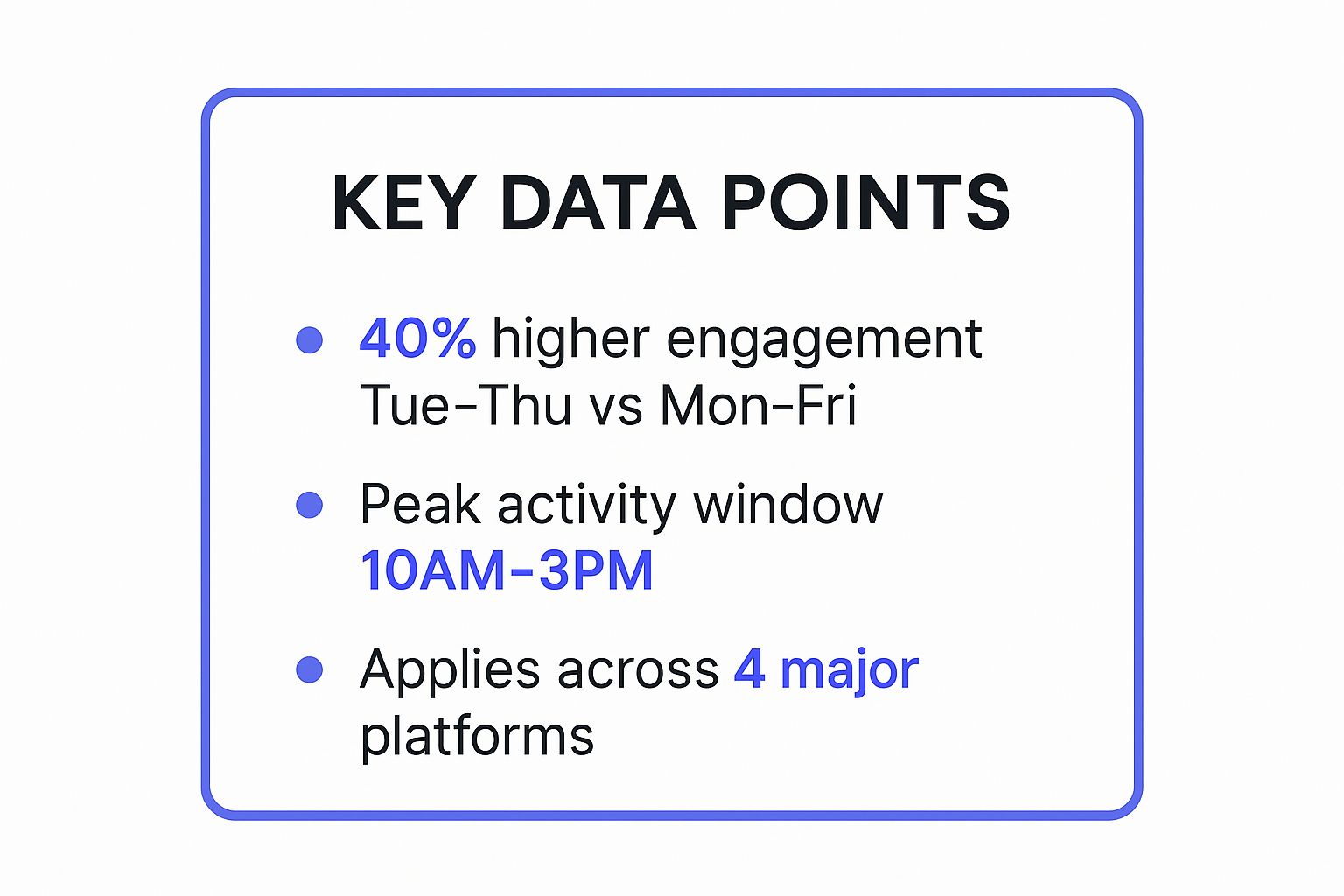
As the data illustrates, the engagement boost during this mid-week window is substantial and consistent across major platforms, making it a foundational tactic.
How to Implement This Strategy
To effectively leverage the Tuesday-Thursday sweet spot, follow these actionable steps:
- Confirm with Analytics: While this window is a strong general rule, always verify it against your own audience data. Use platform-native tools like Meta Business Suite Insights or LinkedIn Analytics to see when your followers are most active.
- Timezone Targeting: Schedule posts based on your primary audience's timezone, not your own. If you have a global audience, consider segmenting posts or finding an overlapping sweet spot that serves multiple regions.
- Batch and Schedule: Consistency is crucial. Prepare your content in advance and use a scheduling tool (like Buffer or Hootsuite) to ensure your posts go live at the optimal times without fail. This prevents last-minute scrambling and maintains a reliable presence.
2. The Instagram Prime Time: 6PM-9PM Daily
While mid-day strategies dominate professional platforms, a different approach is essential for visually-driven networks like Instagram. Targeting the evening hours between 6 PM and 9 PM daily in your audience's local timezone capitalizes on peak leisure activity. This strategy is built on the understanding that users are unwinding after their workday, commuting home, or relaxing post-dinner, making them more receptive to engaging with lifestyle content, stories, and Reels.
This "prime time" window is when casual scrolling transforms into active engagement. Analytics from social media management platforms like Later and Hootsuite consistently show a surge in likes, comments, and shares during these hours. For instance, fashion brands like Zara often see up to 70% higher interaction rates on posts published in the evening. Similarly, food bloggers and restaurants frequently achieve their highest story views and engagement between 6 PM and 8 PM as users look for dinner inspiration or evening entertainment.
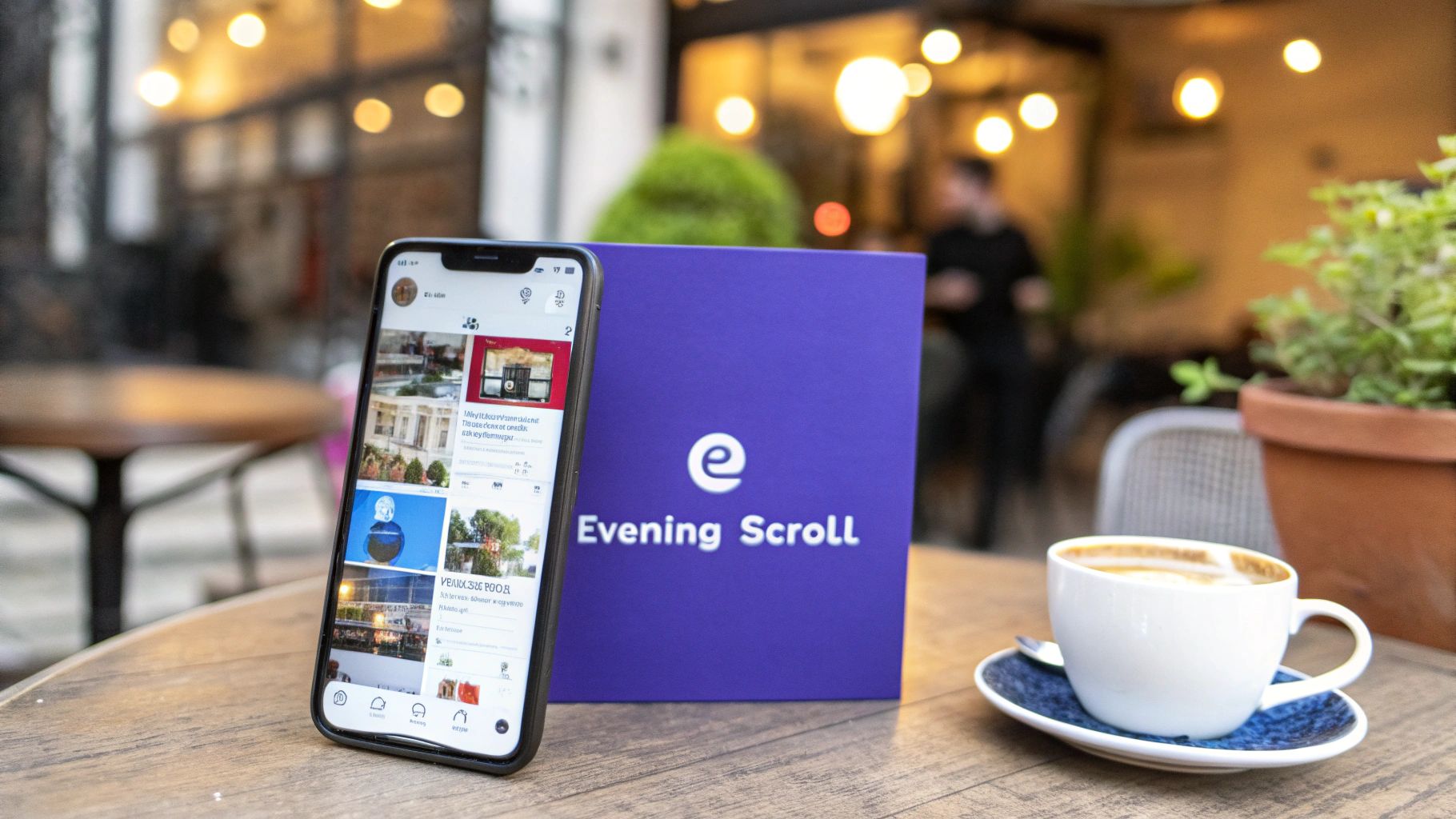
This timeframe is particularly powerful for B2C brands, influencers, and creators whose content aligns with hobbies, entertainment, and personal interests. Determining the best times to post on social media for Instagram often means aligning with your audience's personal downtime rather than their professional schedule.
How to Implement This Strategy
To effectively capture your audience's attention during the 6 PM to 9 PM Instagram prime time, follow these specific steps:
- Pinpoint with Instagram Insights: Use the native Instagram Insights tool to confirm when your unique followers are most active. Navigate to your Professional Dashboard > Total Followers > Most Active Times to see a daily and hourly breakdown. This data is your most accurate guide.
- Create Evening-Centric Content: Tailor your content to an evening mindset. Use interactive features like polls ("This or That?"), question stickers in Stories ("What are you watching tonight?"), and quizzes that are easy to engage with while relaxing.
- Train Your Audience: Consistency is key. By posting at the same time each evening, you can "train" your followers to anticipate your content, creating a loyal viewing habit that boosts initial engagement and signals to the algorithm that your post is valuable.
- Segment by Timezone: If you have a significant national or international following, don't post based on your own clock. Use a scheduling tool to publish content that aligns with the 6-9 PM window in your audience's primary time zones to maximize reach.
3. The LinkedIn Early Bird Strategy: 7AM-9AM
For brands and professionals focused on B2B engagement, one of the best times to post on social media is during the early morning hours on LinkedIn. This strategy targets professionals between 7 AM and 9 AM in their local timezone, capitalizing on the window when they are commuting, catching up on news, and mentally preparing for their workday. It’s a prime opportunity to place your content directly in front of an attentive, career-focused audience before the daily deluge of meetings and tasks begins.
This pre-work routine is when many decision-makers and industry leaders are most active, seeking valuable insights to start their day. By sharing thought leadership and industry analysis during this period, you position your brand as a primary source of information. For instance, B2B software companies have reported generating up to 80% more qualified leads by focusing their content distribution in this 7 AM to 9 AM slot. Similarly, prominent executives and consultants often achieve maximum engagement on early morning posts, establishing a strong presence before competitors even log on.
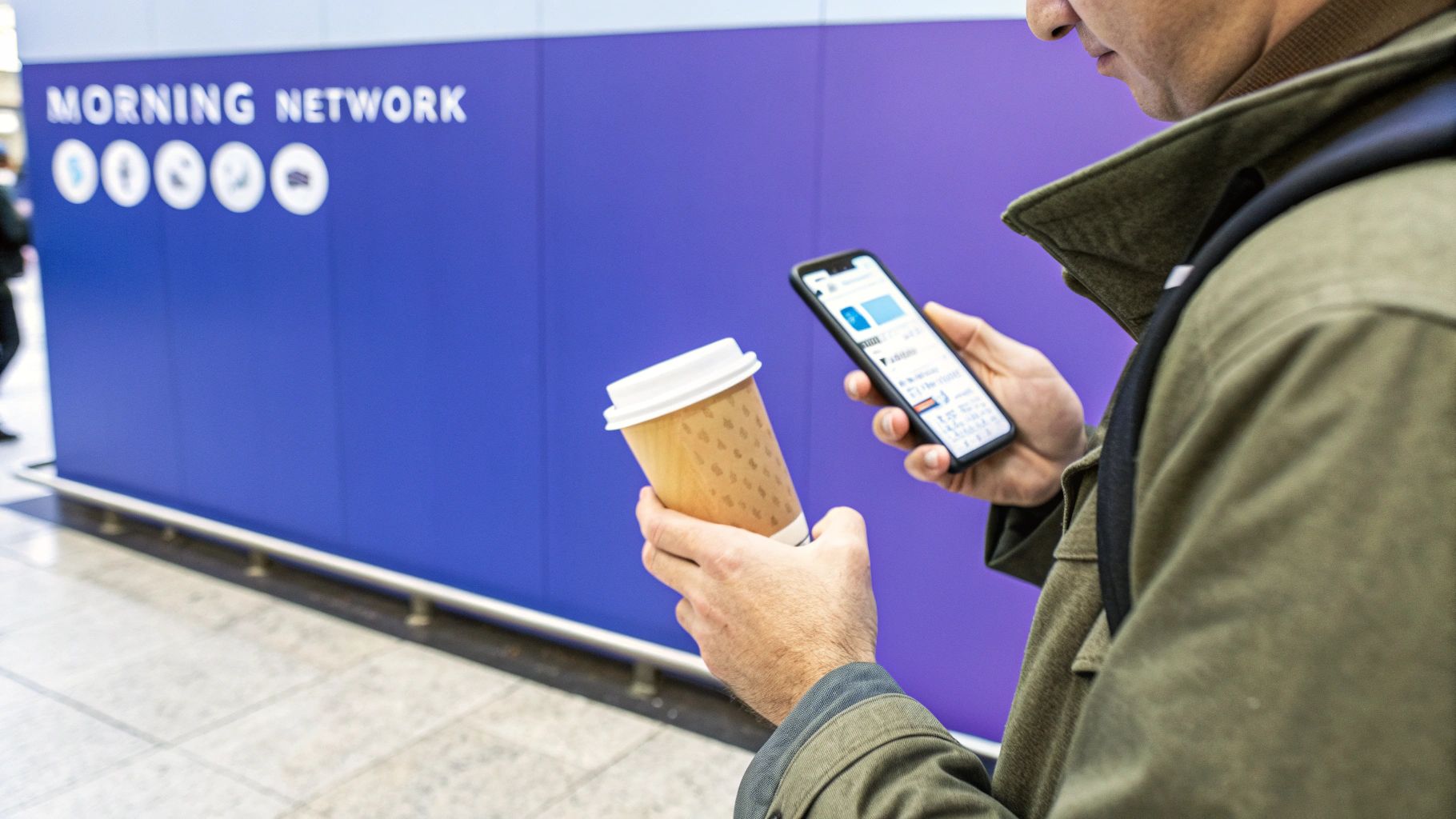
As the data highlights, this early window offers a distinct advantage on LinkedIn by capturing user attention at a peak moment of professional focus and receptiveness.
How to Implement This Strategy
To effectively capitalize on the LinkedIn early bird window, integrate these actionable steps into your workflow:
- Focus on Value-Driven Content: The early morning audience is seeking insights, not sales pitches. Share thought leadership, industry news, quick tips, or data-backed analysis. Content that makes them feel informed and prepared for their day performs best.
- Engage Immediately: Be ready to respond to comments and questions as soon as your post goes live. Early engagement signals to the LinkedIn algorithm that your content is valuable, boosting its visibility in the feed throughout the day.
- Schedule for Consistency: Use a scheduling tool to ensure your posts are published consistently within this timeframe, especially if your target audience is in a different timezone. To master this, you can learn more about how to effectively schedule your LinkedIn content.
4. The TikTok Golden Hours: 6AM-10AM and 7PM-9PM
Unlike traditional platforms, TikTok operates on a unique algorithmic rhythm, making timing a critical component of viral potential. The best times to post on social media for this platform are concentrated in two distinct windows: the early morning (6 AM - 10 AM) and the late evening (7 PM - 9 PM). This strategy targets users' daily routines, capturing their attention when they first wake up and check their phones, and again when they are unwinding and relaxing before bed. The platform's predominantly younger audience is most active during these "golden hours," creating a prime opportunity for high engagement and discovery on the "For You" page.
The power of these time slots is evident in the success of major brands and creators. For instance, brands like Duolingo have mastered this by posting quirky, character-driven content that aligns perfectly with the relaxed evening mood, often garnering millions of views. Similarly, small businesses have gone viral with motivational or behind-the-scenes content posted around 7 AM, catching users as they start their day. This approach, popularized by mega-creators like Charli D'Amelio and MrBeast, capitalizes on peak user activity to maximize algorithmic favor.
Key Data Insights at a Glance
The effectiveness of these golden hours is backed by user behavior data. The morning slot taps into the "first scroll" habit, while the evening slot aligns with peak leisure time. For a deeper analysis of platform-specific data, you can learn more about the best time to post on TikTok on postsyncer.com. This data highlights why aligning with these windows is a non-negotiable for TikTok success.
How to Implement This Strategy
To harness the power of TikTok's golden hours, follow these specific steps:
- Match Content to the Mood: Create content that fits the context of each time slot. Post high-energy, motivational, or informational content in the morning. Reserve humorous, relaxing, or entertainment-focused content for the evening slot to match the user's mindset.
- Leverage Peak-Hour Trends: Use trending sounds and hashtags that are currently gaining traction during these peak hours. The TikTok algorithm often pushes content that participates in real-time trends, giving your posts an extra boost.
- Engage Immediately: Be prepared to interact with comments and questions as soon as your video goes live. Rapid early engagement signals to the algorithm that your content is valuable, increasing its chances of being pushed to a wider audience.
- Test and Refine: While these are strong general guidelines, use your TikTok Analytics (under the "Followers" tab) to identify when your specific audience is most active. Test both the morning and evening slots for a week to see which performs better for your niche and content style.
5. The Facebook Family Time: 1PM-4PM Weekdays
Another highly effective strategy for determining the best times to post on social media focuses on Facebook's core demographic during the afternoon. This approach targets the 1 PM to 4 PM weekday window, a period when many users, particularly parents and older audiences, are winding down their work or taking an afternoon break. This timeframe capitalizes on post-lunch social media checks, end-of-workday scrolling, and the hours when users are often sharing family updates or engaging with community-focused content.
This strategy moves beyond the typical B2B-centric morning rush and taps into the more personal, community-driven nature of Facebook. It aligns perfectly with the platform's emphasis on meaningful connections. For example, local restaurants have reported seeing up to 90% more event RSVPs from posts published in the afternoon. Similarly, family-oriented brands like Disney often achieve higher engagement rates during these hours, while community organizations have seen more volunteer sign-ups from posts made around 2 PM.
Key Data Insights at a Glance
To visualize why this specific afternoon window on Facebook is so impactful, let's examine the data behind user behavior during this time. The video below provides a deeper dive into the metrics and user habits that make this a prime opportunity.
The insights from this analysis confirm that engagement, particularly for community and family-oriented content, sees a significant lift during the mid-to-late afternoon on weekdays.
How to Implement This Strategy
To successfully leverage the Facebook Family Time window, apply these actionable steps:
- Focus on Community Content: Tailor your posts to be family-friendly, community-oriented, and conversation-starting. Ask questions, share user-generated content, and create posts that encourage comments and shares.
- Utilize Facebook Groups: Amplify your reach by sharing your afternoon posts directly into relevant Facebook Groups where your target audience congregates. This can dramatically increase visibility and interaction.
- Leverage Native Video: Facebook's algorithm prioritizes native video content. Posting short, engaging videos during this 1 PM to 4 PM slot can significantly boost your performance and capture audience attention more effectively.
- Automate Your Posting: Consistency during this specific window is key. Using a dedicated Facebook scheduler ensures your content is published at the optimal moment every time, maximizing your potential for engagement. Learn more about how a Facebook scheduler can streamline your workflow and help you nail this timing.
6. The Twitter News Cycle Strategy: 8AM-10AM and 12PM-1PM
Capitalizing on Twitter's (now X) fast-paced, real-time nature requires a unique approach to identifying the best times to post on social media. The Twitter News Cycle Strategy focuses on two key windows: 8 AM to 10 AM and 12 PM to 1 PM in your audience’s local timezone. This timing is rooted in how users treat the platform as a primary source for breaking news and instant commentary. The morning slot captures people as they wake up and check headlines, while the midday window aligns with lunch breaks when users scroll for updates and join ongoing discussions.
This strategy is less about a weekly rhythm and more about a daily pulse, making it ideal for brands that are agile and conversation-focused. News organizations like the BBC and CNN consistently see their highest engagement on tweets published during the morning news cycle. Similarly, a well-timed tweet from a brand like Wendy's during the lunchtime rush can spark viral conversations. The goal is to insert your content directly into the flow of daily information consumption, maximizing visibility and the potential for retweets when user activity is most concentrated.
Key Data Insights at a Glance
Understanding why these specific times work on Twitter involves looking at user behavior patterns. The platform's algorithm heavily favors timeliness and immediate engagement, making these windows especially powerful.
As the data shows, aligning posts with news consumption habits provides a significant lift in impressions and interactions, making this a critical tactic for anyone serious about their Twitter presence. For the latest strategies and optimal times to maximize your reach and engagement specifically on Twitter, delve deeper into the best time to tweet in 2025.
How to Implement This Strategy
To effectively execute the Twitter News Cycle Strategy, follow these actionable steps:
- Monitor Trending Topics: Before posting, check the "Trends for you" section on Twitter. Joining a relevant, existing conversation is often more effective than starting a new one. Frame your content to add value to what people are already discussing.
- Keep It Concise and Engaging: Twitter is built for brevity. Craft tweets that are short, impactful, and include a clear call-to-action or a thought-provoking question to encourage replies and retweets.
- Use Hashtags Wisely: Incorporate one or two highly relevant hashtags to increase discoverability. Avoid "hashtag stuffing," which can make your content look spammy and reduce engagement.
- Be Ready to Engage: The work doesn't end after you post. Be prepared to respond quickly to replies and mentions, especially within the first hour. This real-time interaction signals to the algorithm that your content is valuable and boosts its visibility further.
7. The Weekend Warrior Approach: Saturday 10AM-12PM
While weekday schedules dominate many discussions about the best times to post on social media, ignoring the weekend means missing a massive opportunity. The Weekend Warrior approach hones in on Saturday mornings, specifically between 10 AM and 12 PM, to capture audiences in a more relaxed and receptive mindset. During this window, users are not rushing through their feeds on a quick work break; they are actively seeking inspiration, entertainment, and content to shape their weekend plans.
This strategy is particularly effective for B2C brands whose products or services align with leisure, hobbies, and lifestyle. The content consumption habits on a Saturday morning are fundamentally different from a Tuesday afternoon. Users are more likely to watch longer videos, read detailed captions, and engage in community-focused conversations. For example, lifestyle bloggers often report seeing up to 85% higher engagement on Saturday morning posts, while fitness brands achieve maximum views on workout videos shared during this period. Food and recipe content also performs exceptionally well as people plan their weekend meals.
Key Data Insights at a Glance
The power of this weekend window lies in its ability to tap into a high-intent, low-distraction environment. The data below illustrates why Saturday mornings are a prime slot for specific types of content, showing a clear spike in engagement driven by leisure-time browsing.
As the data highlights, this timeframe delivers a significant boost in shares and comments, indicating deeper audience connection beyond simple likes.
How to Implement This Strategy
To successfully leverage the Saturday morning sweet spot, apply these targeted steps:
- Align Content with a Weekend Mindset: Focus on inspirational, aspirational, or activity-based content. Think "weekend project" tutorials, "Saturday brunch" recipes, or "get ready with me" videos. The goal is to become part of your audience's weekend experience.
- Encourage Community and Conversation: Use this time to build your community. Post questions, run polls about weekend plans, or share behind-the-scenes content that feels more personal and less corporate. This relaxed window is ideal for fostering genuine connections.
- Promote Weekend Activities or Sales: If you are an e-commerce or local business, this is the perfect time to announce a weekend sale, a special event, or a limited-time offer. You catch customers right as they are making purchasing and activity decisions for the next 48 hours.
8. The Commuter's Companion: 7AM-9AM and 5PM-7PM
Another highly effective strategy for determining the best times to post on social media is to target users during their daily commute. This approach focuses on the bookend hours of the traditional workday, from 7 AM to 9 AM and again from 5 PM to 7 PM in your audience's local timezone. The rationale is simple yet powerful: during these periods, millions of people are on public transport or stuck in traffic, turning to their phones for news, entertainment, and distraction.
This strategy captures a captive audience actively seeking content to fill their travel time. Unlike the mid-day break, which can be brief, the commute offers a more extended and predictable window for consumption. It bypasses the morning scramble at the office and the evening wind-down at home. For example, podcast creators often see a 60% higher click-through rate on promotional posts shared during these hours. Similarly, news outlets and educational content creators find significant success with "commute-length" content designed for quick absorption.
Key Data Insights at a Glance
To appreciate the power of this commuting window, it's crucial to understand the user behavior that defines it. The data shows a distinct spike in mobile usage and engagement as people seek to make their travel time more productive or entertaining.
As the data highlights, engagement rates during commute times are particularly strong on mobile-first platforms like Instagram, TikTok, and X (formerly Twitter), making this a prime opportunity for brands targeting those audiences.
How to Implement This Strategy
To successfully leverage the commuter's window, follow these actionable steps:
- Optimize for Mobile and Sound-Off Viewing: Content must be vertically oriented and easily understood without audio. Use bold, clear captions and strong visual cues, as many users will be in noisy environments or without headphones.
- Create Commute-Length Content: Keep videos between 30 seconds and 3 minutes. Design carousels and infographics that can be swiped through quickly. The goal is to deliver value within the average time it takes someone to travel a few stops on a train.
- Consider Commuting Methods: Tailor content to how your audience travels. An audience that primarily drives might respond better to audio content like short podcast clips, while those on public transit are a perfect audience for visually rich videos and articles.
- A/B Test Morning vs. Evening: Test whether your specific audience is more engaged during the morning commute (when they are preparing for the day) or the evening one (when they are unwinding). Their mindset will differ, which should influence your content's tone and call to action.
Best Times to Post: 8-Strategy Comparison
| Strategy | Implementation Complexity 🔄 | Resource Requirements ⚡ | Expected Outcomes 📊 | Ideal Use Cases 💡 | Key Advantages ⭐ |
|---|---|---|---|---|---|
| The Tuesday-Thursday 10AM-3PM Sweet Spot | Medium (consistent scheduling needed) | Moderate (multi-platform management) | High engagement across B2B and B2C audiences | B2B companies, professional services, working adults | Consistent high engagement; less competition; lunch-break targeting |
| The Instagram Prime Time: 6PM-9PM Daily | Medium (high-quality visual content) | High (visual content creation) | Highest organic reach and engagement | Lifestyle, fashion, entertainment, consumer brands | Peak leisure time engagement; max reach; strong shares & saves |
| The LinkedIn Early Bird Strategy: 7AM-9AM | Low-Medium (early consistent posting) | Moderate (thought leadership content) | High-quality professional engagement | B2B, consultants, executives, professional services | Less feed competition; better lead generation; executive reach |
| The TikTok Golden Hours: 6AM-10AM and 7PM-9PM | High (twice daily posting required) | High (engaging, trendy content) | Viral potential with younger demographics | Entertainment, Gen Z/Millennials, viral content | Two daily peaks; algorithm boost; viral content opportunity |
| The Facebook Family Time: 1PM-4PM Weekdays | Low-Medium (afternoon posting) | Moderate (community-focused content) | Steady engagement from core demographic | Local businesses, family brands, community groups | Higher local engagement; family-oriented; less youth competition |
| The Twitter News Cycle Strategy: 8AM-10AM and 12PM-1PM | Medium (timely, trending content) | Moderate (real-time monitoring) | High interaction via retweets and replies | News outlets, thought leaders, B2B, public conversations | Optimal for trending topics; high virality; real-time engagement |
| The Weekend Warrior Approach: Saturday 10AM-12PM | Low (weekly weekend posting) | Low to Moderate (lifestyle content) | Higher engagement and longer content consumption | Lifestyle, fitness, food bloggers, consumer brands | Less competition; deep user engagement; community building |
| The Commuter's Companion: 7AM-9AM and 5PM-7PM | Medium (dual peak times) | Moderate (mobile-optimized content) | Consistent engagement during commutes | News, educational content, entertainment, urban focused | Captures routine users; good video completion; mobile-friendly |
Automate Your Timing for Perfect Execution
Mastering the best times to post on social media is a powerful first step, but it’s consistent, precise execution that truly separates a good strategy from a great one. We've explored the data-backed sweet spots across every major platform, from the early-morning professional focus on LinkedIn to the late-night entertainment scroll on TikTok. However, manually trying to hit every single one of these windows is not just impractical; it's a recipe for burnout and missed opportunities.
Beyond Theory: Putting Your Posting Schedule into Practice
The real challenge isn't knowing when to post, but building a system that allows you to do so flawlessly, time and time again. This is where automation transforms from a convenience into a strategic necessity. Instead of setting alarms for a 7 AM LinkedIn post or a 9 PM Instagram story, you can leverage technology to handle the execution, freeing you to focus on creating high-quality content.
The core takeaway from this guide is twofold:
- Data is Your Compass: The general guidelines, like the Tuesday-Thursday peak or the weekend warrior approach, provide a fantastic starting point. They give you a data-informed hypothesis to test against.
- Your Audience is Your True North: The ultimate "best time" is unique to your followers. The global averages are just that, averages. Your specific audience might be night owls, early birds, or midday scrollers. The goal is to move from general best practices to personalized, data-driven insights.
Your Actionable Next Steps to Master Social Media Timing
To turn these insights into tangible results, you need a clear plan. Here are the steps to take your social media timing from guesswork to a well-oiled machine:
- Establish Your Baseline: Use the platform-specific times detailed in this article as your initial posting schedule for the next 2-4 weeks.
- Analyze Your Own Data: Dive into your native analytics on each platform. Look at your top-performing posts and note the days and times they were published. Do they align with our guidelines, or are there unique patterns emerging?
- Implement an Automation Tool: This is the most crucial step for consistency and efficiency. A robust scheduling tool allows you to "set it and forget it," ensuring every post goes out at the optimal moment without manual intervention. For agencies looking to scale their social media efforts, learning how to master automating repetitive tasks is a proven strategy for growth and profitability.
- Test, Refine, and Repeat: Social media is not static. Continuously experiment with new time slots based on your analytics. Test one variable at a time (e.g., post the same type of content on Wednesday at 11 AM and then at 6 PM) to get clean data on what works best.
By embracing this cycle of learning, implementing, and refining, you move beyond simply knowing the best times to post on social media and into a state of strategic mastery. You ensure every piece of content you create is given the maximum opportunity to connect, engage, and convert.
Ready to stop guessing and start scheduling with data-driven precision? Try PostSyncer today to automate your posting schedule, analyze your unique audience engagement, and ensure your content always hits the mark. Unlock your social media's full potential with PostSyncer and turn perfect timing into your competitive advantage.
